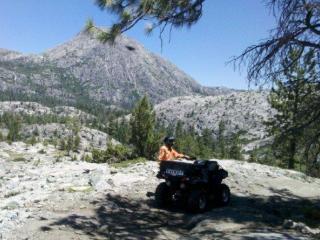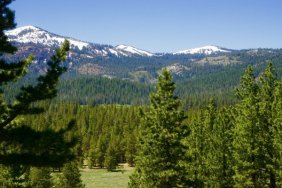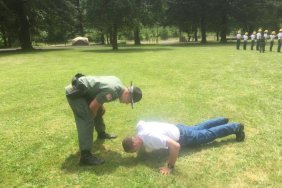 Imagine saddling up on your mountain bike for a fun day of riding in the Sierra Nevada mountains, expecting a day full of adventure and camaraderie as you ride a maze of trails amidst towering pines and the squatting Manzanita. Now imagine those trails becoming a tangled mess of dirt routes as dusk creeps over the horizon, unsure of which trail leads back to the safety of your vehicle. What was supposed to be your day of relaxation has turned to intense panic as reality sets in that you are lost, it’s getting cold and the granola bag is running on empty.
Imagine saddling up on your mountain bike for a fun day of riding in the Sierra Nevada mountains, expecting a day full of adventure and camaraderie as you ride a maze of trails amidst towering pines and the squatting Manzanita. Now imagine those trails becoming a tangled mess of dirt routes as dusk creeps over the horizon, unsure of which trail leads back to the safety of your vehicle. What was supposed to be your day of relaxation has turned to intense panic as reality sets in that you are lost, it’s getting cold and the granola bag is running on empty.
When people find themselves in these predicaments, inadvertently unaware of their location in the great outdoors, there are a dedicated group of individuals ready and willing to help: we call them “Search and Rescue,” better known in the industry as “SAR.” While the term search and rescue often conjures up images of scent-tracking dogs and helicopters scanning the terrain below, many teams also employ the assistance of searchers on ATV’s. Turns out, they’re not just for fun, after all.
Take, for example, the Nevada County Sheriff’s Search and Rescue. This group of approximately 80 mission-ready individuals (all volunteer, mind you) is based in the Sierra Nevada foothills of Northern California and provides search and rescue services in terrain that ranges from rolling hills to serious rugged mountain terrain. While members specialize in everything from tracking, to dog handling and ground searching, if you ask Craig Bachtell, the best part of SAR is ATV work. Bachtell is the leader of the Nevada County Sheriff’s Search and Rescue ATV team, and helps coordinate the 33 SAR members who hold ATV certifications for search operations.
I recently had the chance to chat with Craig, who I’ve also had the pleasure of searching with on missions years ago, and pick his brain about what it takes to be a member of an ATV search team. While many of us use our quads as vehicles for fun, it’s important to remember that these incredible machines can also hold a very utilitarian value, sometimes in the most dire of circumstances.
Our first topic was training. With so much media focus on ATV accidents, Bachtell and his team devote a vast amount of time to training. The process starts with the book work and safety videos, followed by lessons on properly fueling, loading and transporting the quads. While the formalities are a must for safety, it seems to be the allure of riding that gets team members hooked. In the second phase of training, ATV team candidates are taught riding techniques and handling, including proper throttle control, maneuvering with body weight and properly approaching obstacles like side hills and logs. as a chance for Bachtell and other team leaders to assess their skill. And while SAR is serious, business, training for these team members can be a blast, “By the end of the day, most of them don’t want to leave because they’re having so much fun with what they’ve learned,” said Bachtell.
But it doesn’t stop there. For those with interest in going futher, Nevada County SAR also offers a course for its ATV members to expand their skills in an extracurricular course taught on the famous Fordyce Trail, requiring an intense amount of mental concentration and skilled riding.
When training is complete, each of these activities translate to the field. In a search scenario, ATV team members are ideally some of the first folks in the ground. With an ability to move far faster than individuals on foot, ATV’s can be sent out to secure a search perimeter, attempting to ensure that everyone from lost hikers and children to injured hunters don’t end up wandering further away from their last point of contact. But it’s not all riding; team members often dismount their quads and spend time yelling, whistling and attempting to elicit a response from individuals who may be nearby, but out of eyesight. The roar of a quad can be a distinguishing sound for a lost individual to pick out and respond to.
Additional search functions for ATV’s run the gamut from acting as transportation for other searchers to and from search areas located a long distance from incident command centers, as well as offering a quick transport for search victims who have been located safely. The machinery also makes an ideal tool for moving equipment around in the field, as well as offering winch capabilities to assist in rescue operations and search functions in rough territory.
While the ability of the ATV’s is impressive, it’s the commitment of the riders themselves that really makes search and rescue functions of ATV’s a phenomenon. In Nevada County, California, the Sheriff’s office owns 7 ATV’s, however, SAR members themselves own an additional 7 machines; all of which they pay to transport and maintain out of their own pocket – in addition to volunteering their time for search operations and training. Makes and models range from a 1992 Honda 300cc, to an ’04 700cc Polaris. As the team’s leader, Bachtell saddles up his personal 2005 Polaris 800 Sportsman, which, according to his “totally unbiased opinion” is the best option on the market. Because, like everyone else, these guys take pride in their rides.
Sure, volunteering your quad and time for search and rescue is another great excuse to ride, and a fun way to put your hobby to use, but let’s face it: some of these searches are just beginning at 2 in the morning, and others are taking place in the midst of some downright uncomfortable weather. I like to ride when it’s warm, perhaps crisp in the fall, but these volunteers are heading out at all hours, in all conditions, to put their ATV’s to use for a cause. And that is an undeniably noble reason to ride.
For more information on ATV Search and Rescue units in your area, contact your local sheriff’s office or search and rescue team!








